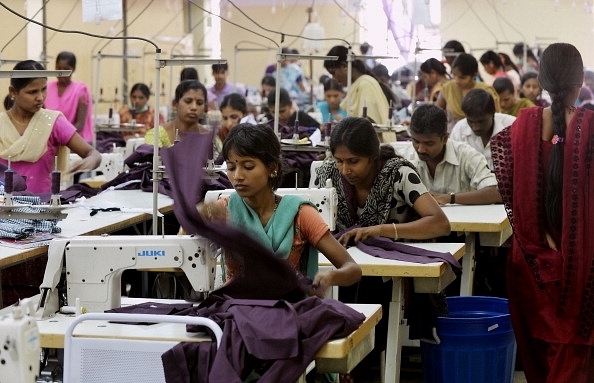Economy
Manufacturing Is Overrated And Past Its Sell-By Date; Services Will Drive Future Growth

Indian labourers in a factory (Manjunath Kiran/AFP/Getty Images)
The spectacular success of Trump’s presidential bid in the United States (US) (so far) and the Brexit vote have forced a debate on the pros and cons of globalisation and free trade. The old political fault lines of left-wing and right-wing politics are waning in the West. As The Economist notes: The new divide in rich countries is not between left and right but between open and closed, i.e., between those who want to close the borders (for both goods and immigrants) and those want to keep it open.
Therefore, increasingly, including in the current US presidential cycle, we see politicians with widely different views on social issues (Trump, Sanders) voice anti-trade tirades. The anti-globalisation rhetoric is the reason why a republican presidential candidate, Donald Trump, is giving a Democrat, Hillary Clinton, a run for her money in the rust-belt states, the traditional manufacturing powerhouse of the US. But why are politicians pandering to factory workers? Does it make political or economic sense?
Consider these facts: Around 1.2 crore people in the US are employed in manufacturing today. In services, the figure is ten times larger: more than 12 crore people work in the services industry. In India, five crore are employed in manufacturing while 11 crore work in the services sector.
Last year, there were 64,000 steelworkers in America and 8,20,000 home health aides. But both Clinton and Trump are promising to create millions of factory jobs rather than improving the condition of those working in the services sector.
Obama promised to create a million jobs too, but hasn’t reached a figure of even half a million. One reason why US politicians are drumming up protectionism could be that the manufacturing states in the country are also the swing states. And while it makes political sense to make the right noises on creating jobs in manufacturing during the election, economically it doesn’t help. As Obama must have realised.
The golden era of manufacturing is gone. As our Editorial Director R Jagannathan writes, “Manufacturing is going through the same process of huge increases in productivity that agriculture witnessed in the 20th century. When productivity increases faster than demand for long periods of time, an industry has to shrink in terms of job growth.”
According to Bruce Greenwald, the Robert Heilbrunn Professor of Finance and Asset Management at the Columbia Business School, manufacturing’s glory days are over, and its demise will lead to a slowdown, if not shrinking, of economies that depend on manufacturing exports – with China, currently the factory to the world, being the biggest potential loser. It’s not coming back. Most of the developed and developing countries now have more people working in services than they do in factories.
So what’s the road ahead? The Economic Survey 2014-15 in a chapter called ‘What to Make in India? Manufacturing or Services?’ argued that “there does not seem to be anything distinctive or superior about registered manufacturing when compared with certain other service sub-sectors.”
Manufacturing is typically hailed for its employment-generating potential. However, a Reserve Bank of India working paper reported employment elasticity of 0.29 for manufacturing and 0.30 for service.
In India and the rest of the world, the obsession with manufacturing makes little sense. Nandan Nilekani, the architect of the Aadhaar project, believes that India is going to be a services-driven economy.
However, for a country the size of India, the option cannot be to abandon the manufacturing space altogether. We constantly need to beef up our efficiency if we wish to make a dent in this sector and grab some space ceded by China.
Bruce Greenwald says that, “The global productivity growth in manufacturing properly measured is 5 percent to 7 percent a year, and manufacturing demand is maybe 3 percent annually.” This means that if we do not increase productivity growth faster than 5-7 per cent annually, our manufacturing growth will shrink, as technology and demand kill off new investments.
The Economic Survey also rightly cautions that “the choice for India is not manufacturing versus services, but comparative advantage deifying (unskilled-intensive) sectors versus comparative advantage defying (skill-intensive) sector development.”
Support Swarajya's 50 Ground Reports Project & Sponsor A Story
Every general election Swarajya does a 50 ground reports project.
Aimed only at serious readers and those who appreciate the nuances of political undercurrents, the project provides a sense of India's electoral landscape. As you know, these reports are produced after considerable investment of travel, time and effort on the ground.
This time too we've kicked off the project in style and have covered over 30 constituencies already. If you're someone who appreciates such work and have enjoyed our coverage please consider sponsoring a ground report for just Rs 2999 to Rs 19,999 - it goes a long way in helping us produce more quality reportage.
You can also back this project by becoming a subscriber for as little as Rs 999 - so do click on this links and choose a plan that suits you and back us.
Click below to contribute.
Latest